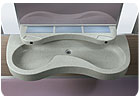
Saving Water with commercial faucets is old news these days ever since federal mandates started determining flow rates, as well as flush rates for that matter, of common plumbing products 15 years ago.
However, advancements in how to power the sensors that turn the water on and off are a relatively new development. Almost two years ago, we flew to Colorado to attend a media preview of a “green” Wal-Mart Supercenter, built with various ways to help the retailing giant trim its energy costs and build its big boxes in a more eco-friendly manner.
Most green building techniques were hard to miss, such as the 120-foot-tall turbine outside that provided some of the electricity to run the 206,000-square-foot store. Inside the restrooms was another way to save electricity - and infinitely more practical than a 12-story windmill. Photovoltaic cells were impregnated right into the counters of the sink, converting light (or rather room lighting) into electricity to control the sensors.
Bradley Corp. supplied Wal-Mart with its Express series of lav systems outfitted with the proprietary technology, which the company calls ndite, to convert the light into power. After an initial half-hour charge, the company says the lights could be turned off for five days and the system would maintain its charge.

The company more recently introduced a retrofit kit that can convert any of its SS and MG series Express lavs with the photovoltaic system.
A few years ago, Sloan Valve Co. also came out with a solar-powered, touchless faucet called Solis. In the case of Solis, the photovoltaic material is actually on the top of the faucet itself.
While such faucets may do their part in saving electricity, those energy-savings may be modest compared to the energy saved over infighting between the electrician and the plumber. Both do away with the need to hard-wire the installation of the faucets.
While using the power of the sun is in vogue, at least one other manufacturer is using another alternative energy source to power a line of its electronic faucets. Toto turns it EcoPower faucets into miniature dams, using the water flow itself to recharge the batteries. The company says all it needs are five people a day to wash their hands to provide a suitable charge.